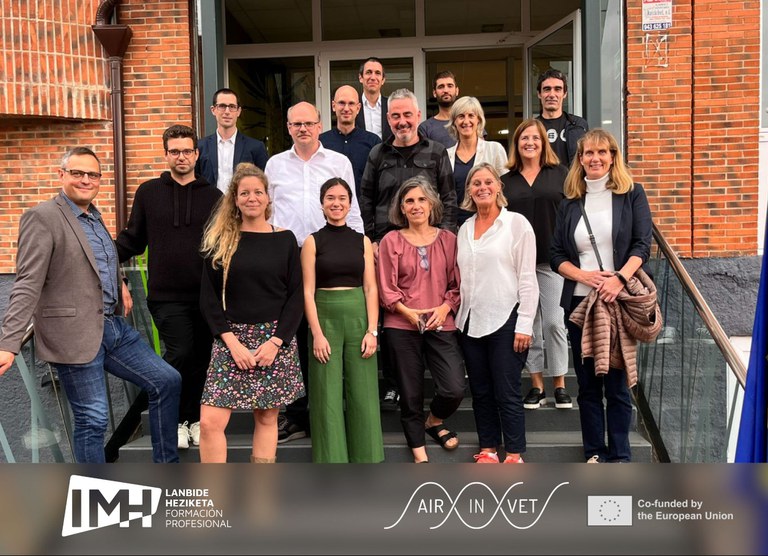Results and recommendations of the AIRinVET project on applied innovation in Vocational Education and Training.

The AIRinVET project, Innovation and Applied Research in Vocational Education and Training (AIRinVET), aims to bridge the gap between VET institutions and SMEs by generating sustainable partnerships that directly address industry challenges.
This approach enables teachers to acquire practical skills while contributing to innovations that benefit both SMEs and their communities.
The AIRinVET project partners have made the final presentation of the results obtained during the two years of the project. To this end, the forum held on 16 October in Tknika brought together institutional, business and industrial representatives from Europe and Canada.
Project Highlights and Key Contributions collected at the 16 October forum:
Framework for Applied Research: The project has established a European reference framework that enables VET institutions to implement research initiatives effectively. This framework includes flexible guidelines that allow VET institutions to adapt to the specific needs of their local SMEs and industrial sectors.
Collaboration and Knowledge Dissemination: A central theme was the role of VET in disseminating knowledge within local and regional ecosystems. As Inigo Mugika (Tknika) highlighted in his intervention, this framework allows VET institutions to connect with various actors, including SMEs and regional innovation agents, to promote meaningful community-driven innovation.
Open access innovation: The forum underlined the importance of open access results to foster transparency and collaboration. Henning Klaffke (BHH Hamburg) highlighted that by making project results publicly accessible, VET institutions can attract more industry partners and broaden the scope of future research and training initiatives.
Real impact on SMEs: Through case studies, Josu Riezu (AFM) and Oier Uriarte (IMH) demonstrated how VET institutions can play an active role in solving real challenges faced by SMEs. They shared examples of successful collaborations where VET research contributed to economic growth and increased competitiveness, especially in key sectors for Europe's green and digital transitions.
Overcoming Barriers and fostering enablers: Juan Manuel Mondejar (Projar Group) highlighted the importance of long-term collaboration, mutual understanding and adapting project timelines to overcome existing barriers between VET and SMEs. This approach builds trust and aligns project objectives with the needs of SMEs, creating a win-win scenario for both parties.
International cooperation for greater impact: Speakers such as Diane Burt from Canada highlighted the role of cross-border collaboration. She pointed out that international cooperation allows VET institutions to share resources, exchange best practices and prepare students for a globalised labour market.
Looking ahead: ensuring accessibility and future growth. The AIRinVET framework, developed through extensive collaboration, will be available online in several languages, making it accessible across Europe. This tool will enable VET institutions to assess their research and innovation capacities, receive personalised recommendations and further develop their impact within their communities.
As Jakub Grodecki (EURASHE) pointed out in the closing remarks of the symposium, the work of the AIRinVET project is far from over. ‘We are building a stronger and more relevant VET sector,’ he said. ‘The support of policy makers, educators and industry partners is crucial to maintain this momentum and create a resilient and innovative European economy.’
The AIRinVET Project invites SMEs and VET institutions across Europe to learn about the new framework, engage in collaborative research initiatives and contribute to the next generation of skilled professionals to meet the challenges of the future.
Main milestones of the project:
Development of Tools and Conceptual Framework: A glossary and business model for applied innovation in VET has been created, establishing common terms and a conceptual basis.
Knowledge Gathering and Case Study Analysis: Based on interviews with various organisations and countries, case studies of successful collaboration between VET institutions and companies to solve real problems have been identified.
Analysis of Barriers and Enablers: The ways of thinking of educational agents, industrial representatives and communities towards applied research have been studied, identifying facilitating factors and obstacles to overcome.
Creation of a Roadmap: With different levels of development, a roadmap has been created to enable VET institutions to integrate applied innovation into their organisations, forming the AIRinVET framework for Applied Research and Innovation.
Exchange and Recommendations: Online sessions were held to facilitate the exchange of experiences between countries. The conclusions and recommendations gathered will serve as a guide for implementing applied research innovation activities.
More information, AIRINVET PROJECT


